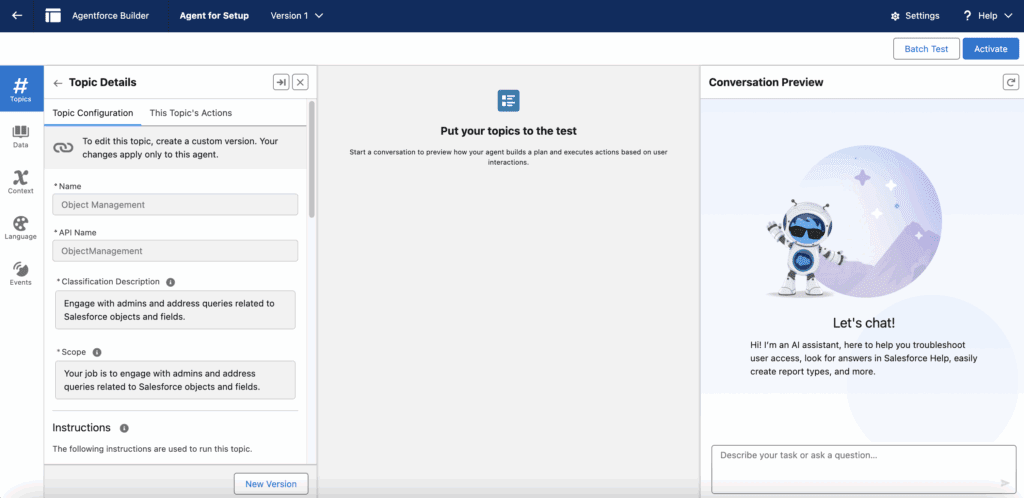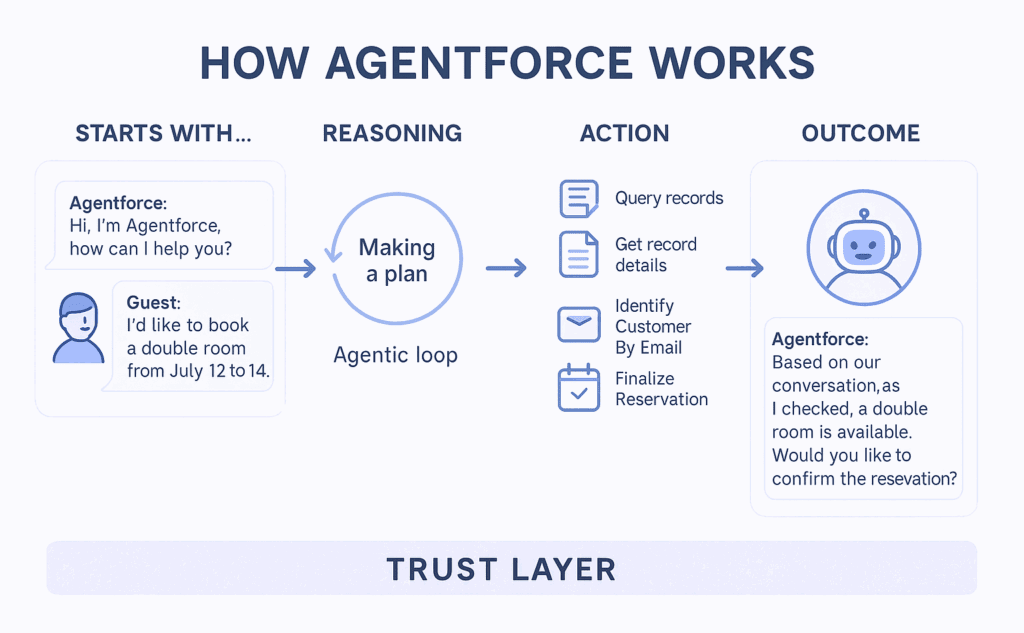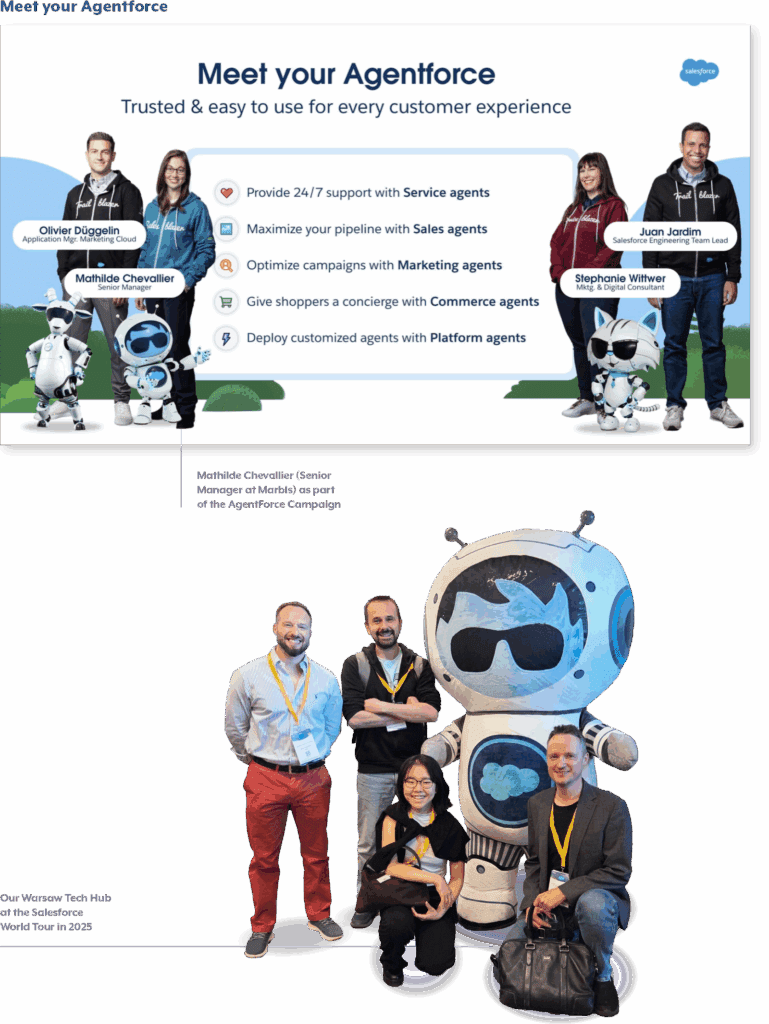The two letters: “AI” evoke various reactions. For some people it is excitement for other it is curiosity or even fear. No matter what feelings it brings Artificial Intelligence is present with more and more aspects of our lives being really useful and even fascinating for people all over the world. OpenAI ChatGPT proved it undoubtedly reaching 1 million users in 5 days only. Salesforce is also one of the companies that put AI very high in their strategy declaring in 2014 they would “become an AI-first company”.
Salesforce AI – a bit of history
With the above-mentioned declaration Salesforce set up an AI focused development team in 2014. One year later the team built the Opportunity Scoring app using AI taking into account different factors to predict how likely the opportunity will be won and assigning each opportunity with a rating to help end users to focus on the right ones. It was 2016 when Salesforce Einstein was launched. Einstein as the first comprehensive AI for CRM became available as part of Sales, Service and Marketing Cloud to predict, provide insights, recommend actions and automate tasks. Einstein has been developed since then introducing new functionalities such as: Einstein Voice, Einstein Vision, Einstein Search, Prediction Builder and many more.
Finally, in 2023 Einstein GPT was launched – announced as the first generative AI CRM technology. Einstein was able to generate personalized content, based on customers’ natural language prompts, using OpenAI ChatGPT and Salesforce private AI models. It included Einstein GPT for Sales, Einstein GPT for Service, Einstein GPT for Marketing, Einstein GPT for Slack Customer 360 apps and Einstein GPT for Developers and offered variety of useful features like auto-generating emails or knowledge articles, automatic personalized chat replies or even Apex code generating assistance. Year 2023 was definitely a breakthrough, and the following year brought even more Einstein capabilities as Einstein Copilot was officially released. Einstein Copilot was a conversational AI assistant grounded in the customer’s business data and metadata. Since it was able to understand the context, it provided users with accurate, high-quality responses. Moreover, the responses could be further customized in Prompt Builder tool to better meet user’s needs. It used pre-built actions (also allowed creating custom actions) and a reasoning engine interacting with a Large Language Model (LLM) to complete complex tasks including updating and creating records. It was available across different Salesforce apps helping users with summarizing records, drafting personalized emails, creating cases, suggesting knowledge articles, analyzing data, recommending responses, etc.
Agentforce – what is it?
So, what is Agentforce? Is it just the rebranded Einstein Copilot with the same or slightly updated functionalities? It is definitely more than that. Salesforce announced it as “a groundbreaking suite of autonomous AI agents that augment employees and handle tasks in service, sales, marketing, and commerce, driving unprecedented efficiency and customer satisfaction”. The key word here is autonomous – that means agents can complete complex and multiple tasks in order to achieve goals established by human but without human help, as opposed to Einstein Copilot requiring human interaction. They use Atlas Reasoning Engine to analyze retrieved data, make decisions and take appropriate actions based on user’s requests or questions. Agents can understand the context of a conversation and learn from user’s feedback or even detect human’s emotions to be more effective and take smarter decisions. Agentforce can handle not only structured data coming from CRM (as Copilot did) but also unstructured data in Knowledge articles or PDF files. Without additional mapping or training Agentforce using LLM can process unstructured data to find the right information and provide the right answer.
There are several types of agents with many capabilities available by default. Among them we can find Service Agent helping customers by answering their questions or creating cases, Sales Development Rep (SDR) sending personalized emails to prospects or scheduling meetings, Agent for Setup helping admin users with managing orgs by finding relevant Salesforce documentation or checking users’ permissions. It is also possible to create a custom agent to cater for individual needs.
How does it work?
Each agent’s behavior is based on a natural language description of the business context, what the agent needs to do, what it is allowed to do and what its limitations are. For this, every agent requires at least one standard or custom topic assigned. Topics contain a brief description of when they need to be used, their scope and a set of instructions precisely explaining when and what to do. Each topic has one or more actions included while actions are responsible for getting agents do their jobs. These are the tasks that an agent completes in order to provide a user with the final outcome. There are several standard actions available out of the box like Query, Update or Summarize Records, Create Case, Log a Call, Draft or Revise Email, etc. Using standard actions along with standard topics makes it easier to have an agent, able to execute many common requests, up and running relatively quickly. Apart from standard ones, custom actions based on Apex classes, flows or prompts performing complex tasks can also be created and added to the topic.
Agentforce Builder: Agent for Setup, Object Management standard topic

An active agent can use all this information in a conversation with a user but how does it know which topic to pick or which action should be taken in a particular situation? The answer is Atlas Reasoning Engine. Everything starts with an input coming from a user (chat, email, etc.), a process (trigger, flow) or another system (APIs). The Agentforce is invoked to generate a plan. It uses LLM to understand the intent and select the appropriate topic. Then, based on the scope and instructions, it will choose the right actions to complete the request from the ones assigned to the selected topic. After performing the first action, it will evaluate the output and loop through other actions if needed. The final outcome is then checked to make sure it follows the established guardrails and sent back.
How Agentforce works

Einstein Trust Layer
As it was mentioned above, Agentforce has access to company’s structured and unstructured data and it uses LLM while working on the responses. On the one hand, it means the outcome it provides is more accurate and personalized, on the other hand though, it may raise questions about the data privacy and security. To answer them, Salesforce came up with a set of features, controls and policies called Einstein Trust Layer. With Einstein Trust Layer the prompt is first enriched with the latest company information coming from CRM or Data Cloud respecting the permissions of the user entering the prompt. Furthermore, prompt injection detection can be enabled to prevent LLM from generating unintended responses. The prompt is then securely sent to LLM using TLS encryption and, as per zero data retention policy, the data is not retained and neither used for LLM training. The response generated by the LLM is sent back to Salesforce and evaluated for toxic content. Finally, it is given a toxicity score and logged in audit trail.
Final Considerations
Undoubtedly, Agentforce is a big step ahead in AI evolution. Autonomous agents can work independently on different tasks increasing productivity and efficiency. Salesforce boasts about the growing number of customers using Agentforce such as Royal Bank of Canada, Accenture, Finnair or even Heathrow Airport. Moreover, UFL has chosen Agentforce to provide real-time insights during game broadcasts on FOX Sports.
Does it mean it can fully replace humans and should be immediately implemented by every company? Of course not. Here are some of the things that need to be considered. One of the most important factors is the use case. There is a variety of fields in which Agentforce can be really helpful like Technical Support, Order or Appointment Management, etc. Life Sciences should also be mentioned here as Agentforce can support organizations in many ways such as helping them more effectively identify the appropriate candidates for participating in clinical trials. Sales reps can get insights on product shortages, they can also be assisted with automated email communication with stakeholders or adjusting their visit plans. Patient services teams can use agents to collect missing patient information or receive alerts informing them about potential delays in patient’s treatment. It needs to be thoroughly analyzed though, whether Agentforce can make a difference for the companies planning to employ it and how it can be used to replace employees in handling repetitive tasks to give them time to focus on other more important assignments. This is crucial especially if pricing is concerned, which may be a barrier for many Salesforce clients.
Agentforce is deeply integrated with Salesforce ecosystem which is a good and a bad thing at the same time. Current Salesforce clients can use it with their existing applications. For the companies not using Salesforce before, implementing Agentforce will be a complex process requiring a lot of preparations and employees’ trainings. Finally, building topics and actions properly is essential to get accurate and consistent responses. Although it is done using natural language, it is not an easy task and may require additional training. Clear instructions must follow best practices such as: be specific, provide context, use consistent words, use absolutes intentionally, check if instructions are not contradictory, avoid adding too many instructions, etc. Moreover, they should be tested very thoroughly as poorly written instruction can cause agent responses to be misleading, and wrongly selected action can make an agent useless or even be harmful for the business.
So, is Agentforce a gamechanger? The answer solely depends on the strategy of the company that considers implementing it.
At Marbls we constantly develop our skills and follow new technologies. We attend industry events to learn from the experts to be able to apply innovations into our applications and continuously improve customers’ experience. Currently, we are exploring Agentforce capabilities to assess if it can be useful for users of our State Price Transparency product (Spark) assisting them in their work by providing necessary information in a form of a simple chat between a user and an agent. Quick access to different Spark data like products, state reporting requirements, submission templates, price threshold rules or answering simple questions based on CRM database or FAQ pdf files are some of the examples of how an agent can potentially boost users’ efficiency. An agent can also help users through automation of creating new records for new submissions or product price data. What is more, Agentforce with custom actions using flows or apex could possibly complete more complex tasks like price increase impact analysis and promptly share the results in a conversation.
With this variety of use cases will Agentforce prove its worth? Our team works hard to investigate it considering different aspects mentioned in this article, so… Stay tuned!
